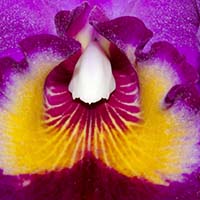
|
AUSTIN
CREEK ORCHIDS
|
|
Orchid Culture
|
 |
 |
 |
 |
 |
 |
 |
The American Orchid Society (AOS) has developed culture sheets for many different types of orchids. These sheets are available on their website and can be downloaded and printed free of charge.
A beginning grower can usually achieve reasonable results by following the general culture guidelines provided by the AOS and others. However, in order to be a good or excellent grower, you need to watch and listen to your plants and adapt your own particular cultural practices to their individual needs.
There is no single "right" answer to orchid culture. What works well for one person does not necessarily work for another. Why? There are just too many variables for a hobbyist grower (or even most commercial ones) to precisely control. For example, differences in available light, temperature and potting media will all affect watering frequency requirements.
The orchid plants offered on this website were grown in a greenhouse under the following general conditions:
Temperature: Summer - 50-55° nights and 80-85° days. Winter: 55-60° nights and 65-70° days.
Humidity: 50-65% during the day, higher at night.
Light: 1500 - 2500 footcandles. Our plants get more light (particularly in the summer) than that provided by some growers. Under higher light conditions, air movement is more important to prevent leaf burning and discourage pests.
Water: We use well water with about 280 ppm in dissolved solids. Generally, a relatively low ppm (< 100) is desirable. However, depending on the particular mineral content, a natural water source may actually provide valuable trace elements that are necessary for proper plant metabolism. Most orchids in nature are accustomed to relatively pure water sources. If your water supply has more than 500 ppm in dissolved solids, you may want to consider an alternative source, such as rain water or Reverse Osmosis (RO) filtered water. In the summer, we water about once every 1 to 7 days, depending on the type of plant and pot size. In the winter, we typically water once every 7-10 days and only on sunny days (when possible).
Fertilizer: We fertilize "weekly, weakly" using a balanced fertilizer (e.g. 10-10-10) containing additional trace elements. (The purer your water source, the more important supplemental trace elements become because waer source is less likely to contain all of the micronutrients that are required for good plant metabolism.) During warm temperatures and active growth, we use a fertilizer mixture with a total dissolved solids of around 500 ppm, including the 280 ppm dissolved solids from our water source. (Depending on the starting ppm of your particular water source, this concentration can typically be achieved by using 1/2 to 1/4 the strength recommended on the fertilizer label.) We continue to fertilize in the winter, but at a reduced concentration. Prior to fertilization, the plants are watered generously with regular water to flush accumulated salts from the potting media and to pre-wet the plant roots. The fertilizer mixture is then applied a few minutes later.
Air movement: Several over bench fans provide air circulation 24 hours per day, 365 days per year.
Potting Media: For most plants offered, we use a mix consisting of 4 parts fir bark, 1 part perlite and 1 part charcoal. The particle sizes used in the mix are varied according to the type and size of plant. For example, we use a mix with medium bark chips and large (#3 or #4) perlite for most blooming size Cattleya plants, whereas we use a fine bark mix for most Oncidium. We use a fine bark mix for seedlings of most genera.
Since orchids have varying cultural preferences, we try to take advantage of certain microclimates within the greenhouse. For example, sun loving Vandas are grown in baskets hung near the greenhouse roof. Cooler growing pleurothallids are grown near the evaporative cooler pads so that they will receive plenty of cool, moist air in the warmer months.
 |
© 2002-2024 Austin Creek Orchids - All rights reserved - Updated: June 18, 2024 |